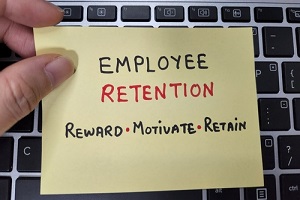 Businesses devote a significant amount of resources to recruiting and hiring, and it is important to protect this investment by ensuring the right candidates are selected for each role, and that every employee is motivated to remain with the company.
Businesses devote a significant amount of resources to recruiting and hiring, and it is important to protect this investment by ensuring the right candidates are selected for each role, and that every employee is motivated to remain with the company.
Keeping employees on board has such a significant effect on the productivity and finances of a company that many businesses are now working with professional benefits consultants to develop employee retention strategies. Here is a look at what employee retention entails and the advantages of this approach.
What Is Employee Retention?
Employee retention is a term for the processes and strategies used by an organization to retain top talent and keep turnover to a minimum. It is now one of the top issues being addressed in workforce management.
According to Oracle NetSuite, large American businesses lose more than $1 trillion a year as a result of voluntary employee turnover. An effective employee retention strategy may have prevented a large portion of turnover.
Employee retention strategies can benefit organizations in many ways.
Better Morale
 When there is a constant cycle of employees being hired and then walking away from the job, employee morale can decrease substantially. The social component of a workplace is crucial for many employees, and companies, where workers enjoy a strong bond, tend to see less turnover. In addition to losing connections when coworkers leave, employees often end up taking on a greater workload to make up for the constant turnover, which can lead to resentment.
When there is a constant cycle of employees being hired and then walking away from the job, employee morale can decrease substantially. The social component of a workplace is crucial for many employees, and companies, where workers enjoy a strong bond, tend to see less turnover. In addition to losing connections when coworkers leave, employees often end up taking on a greater workload to make up for the constant turnover, which can lead to resentment.
Employees who are otherwise satisfied with their job may start to question their future if they are surrounded by turnover. Some might start to wonder why others are not willing to stay on board and begin looking for new positions for themselves as well. A successful employee retention program allows employees to enjoy greater connectedness and engagement and promotes a positive work atmosphere.
Greater Productivity
Although the expense of recruiting and hiring is often discussed in terms of dollar amounts or percentages, there is also the associated loss of productivity to consider. New hires can take one or two years to reach the level of productivity of existing employees, and they also need time to form bonds with their coworkers and clients.
Meanwhile, organizations that are frequently operating with reduced staff because of turnover will likely experience significant productivity losses due to employee burnout and excessive overtime, which can also lead to delays, missed deadlines and lower-quality work overall. High-retention workplaces, in contrast, enjoy more engaged workers who accomplish more each day.
More Efficient Training and Recruitment
Businesses with an effective employee retention strategy can avoid the time and financial expenses involved in finding, onboarding and training qualified employees. When new hires leave an organization, all of this investment is lost. A focus on retention can streamline recruitment and training efforts.
Another effective approach is recruiting from within the organization, as employees who are already familiar with the inner workings of a company often cost less to train and re-skill than outside hires.
Lower Costs
Recruitment involves many different costs, including advertising, interviewing, screening, onboarding and training. However, there are also hidden expenses in the form of lower engagement, compromised customer service and lost productivity that comes with turnover which can also impact the bottom line of the affected organization.
Customer Experience Improvements
 Customer experience plays an important role in a business’s success. This refers to the perception customers form based on their interactions with the business, from the first contact to post-sales support. The way that employees engage with customers has a significant influence on this impression.
Customer experience plays an important role in a business’s success. This refers to the perception customers form based on their interactions with the business, from the first contact to post-sales support. The way that employees engage with customers has a significant influence on this impression.
Turnover can damage the customer experience in many ways. Customers often sense the negative atmosphere that is created by unhappy employees and may take their business elsewhere. In industries and roles that depend on building positive client relations, a revolving door of employees prevents important bonds from forming.
In addition, new employees sometimes take longer to become comfortable with a role and may be slower in carrying out work and solving problems, which can lead to negative customer interactions. These are mistakes that no organization can afford to make at a time when unhappy customers can share experiences online and damage the reputation of a business with ease.
More Satisfying Employee Experience
The employee experience must be as effective and pleasant as the customer experience. Their interactions within the organization need to be positive, including those with clients, coworkers and management. Ensuring that all the members of a team can work together harmoniously can go a long way toward keeping top talent on board.
Deeper Employee Expertise
The longer that employees remain with an organization, the more time they will have to develop expertise in their field. Longevity gives them the perspective needed to understand the organization’s nuances and procedures that are not apparent to new hires. As employees stay with a company for a longer time, they provide more value as their dedication to improving the business’s outcomes increases.
Greater Employee Engagement
Employee engagement is inextricably tied to retention, with engaged employees far more likely to continue working with an organization than those who feel left out. Some of the benefits of a highly engaged workforce include better employee health, lower absenteeism, improved customer service and higher employee loyalty, all of which can drive a company to greater success.
Better Company Culture
 The culture of a company impacts whether employees stay or pursue other options. Many workers say that a company’s culture is a driving factor in deciding whether to work for them in the first place, and it can be equally influential on an employee’s decision to continue working there.
The culture of a company impacts whether employees stay or pursue other options. Many workers say that a company’s culture is a driving factor in deciding whether to work for them in the first place, and it can be equally influential on an employee’s decision to continue working there.
Employees feel more connected to their work, coworkers and the organization itself when working within a positive culture. A good company culture will celebrate employees as individuals and offer great employee benefits that recognize the value of having a better work-life balance. When employees feel that the company they work for cares about them on a human level, they are more likely to stay with an organization and flourish in their role.
Develop a Winning Employee Retention Strategy with Business Benefits Group
Employee retention efforts can directly impact the success of an organization. For help developing a winning employee retention strategy, contact the benefits consultants at Business Benefits Group (BBG) today.


